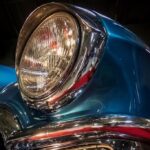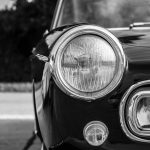Driving on varying types of roads, and in inclement weather can be challenging even for the most advanced driver. Snowfall, fog, sleet, dust storms, or rain, coupled with darkness and uncharted roads can make even the best driver ‘white-knuckle’ it down the road. Knowing when and how to use your vehicle’s low beam, high beam, and fog lights is paramount to not only ensure that you can see, but also that you’re visible to other drivers. This guide will cover when and how to effectively use these lights in varying weather conditions, contributing to your and others’ safety on the road.
Daytime Lighting Usage
Turning on your headlights during the day, even for vehicles with Daytime Running Lamps (DRLs) might seem counterintuitive and completely unnecessary when the Sun is shining and the birds are chirping. However, there are certain conditions where daytime headlight usage can make a significant difference in safety.
Adverse Weather
In conditions such as rain, snow, fog, sleet, or a dust storm, daytime visibility can be severely reduced. Using low beam headlights and fog lights during these conditions can help other drivers see your vehicle, thereby reducing the risk of accidents.
Mountain and Rural Roads
Narrow winding lanes often found on mountains and rural roads can limit visibility, creating potentially dangerous situations when entering or exiting a sharp curve. Using low beam headlights can help make your vehicle more noticeable to oncoming traffic thereby reducing the risk of head-on collisions.
Sunrise and Sunset
The period immediately after sunrise, and before sunset often presents a period of compromised visibility that goes unnoticed due to the gradual ambient illumination transition from dark to bright, or bright to dark. Using low beam headlights can help by ensuring consistent forward illumination which reduces eye strain and increases your response time.
Tunnels
After you enter a tunnel, your pupils will still be acclimated to the external daylight, for unlit or poorly lit tunnels this sudden reduction in ambient light will cause temporary blindness until your pupils dilate to the new ambient light conditions. Ensuring your low beam headlights are on will aid in providing the light needed to minimize this sudden blindness effect both while entering and exiting the tunnel.
State Laws
Some states mandate daytime headlight use under certain conditions. For example, many states require if your windshield wipers are in use, headlights are also required, this information can be found in your state’s DMV booklet.
The Use of Low Beam Lights
Low beam headlights are designed to provide short-range illumination, typically about 200 feet, while minimizing the light directed into the eyes of oncoming drivers (IMAGE 1). Legal DOT lights are carefully designed by optical engineers to ensure a balance between light output, and the amount of glare they produce for oncoming drivers.
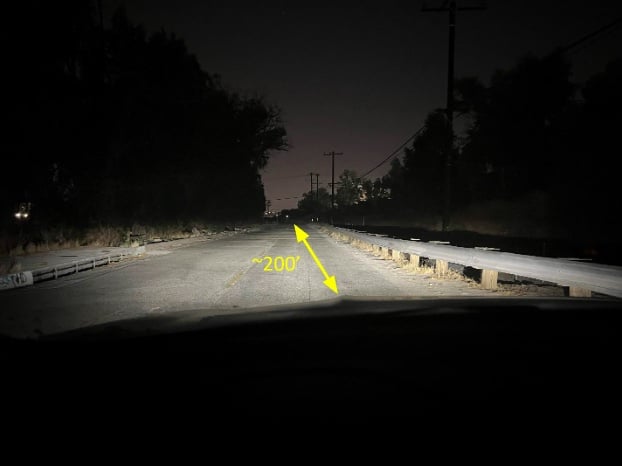
Driving in Traffic
The limited illumination offered from low beams is ideal for driving in heavy traffic, cities, and high-density urban areas, these are areas where high beams will likely blind pedestrians and other drivers.
Adverse Weather
Driving in fog, rain, or heavy snow warrants the use of low beam lights, and fog beams if your vehicle is equipped with them. The downward-directed light from low beams is well suited to cut through these low-visibility situations, and fog beams help to illuminate the road directly in front of your vehicle. High beams, on the other hand, actually impair your ability to see by creating excessive blinding glare for you, the driver (IMAGE 2). This is due to the horizontal light rays reflecting off the water molecules in the air directly in front of your vehicle, which are then redirected back towards your eyes. So contrary to what others may say, do not use high beams in these situations, they will do more harm than good!

Increasing Visibility with High Beam Lights
High beam headlights provide a wide and tall area of bright light, usually project about 350 to 400 feet, and are not designed to limit light directed at oncoming traffic. These lights are specifically designed to provide the most light possible, while not exceeding legal illumination limits.
Dark Roads
High beam lights are best used when traveling on dark roads, where the extra light can help you see farther and more broadly (IMAGE 3). High beams can increase your visibility to about a city block’s distance, thereby enhancing safety. This is particularly useful when driving on dark streets or highways, especially where pedestrians, cyclists, or small animals may be present.
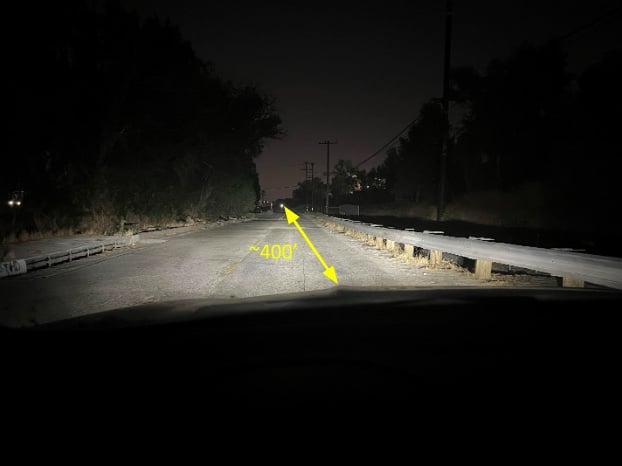
Rural Roads and Highways
On rural roads, where there could be large animals, or on highways with minimal traffic, high beam lights are very beneficial. However, to avoid blinding the other drivers it’s crucial to switch back to low beams when another vehicle is approaching, or if you are following another vehicle. As a general rule of thumb, it is best to switch back to the low beam lights when another vehicle is within 500 feet or 150 meters from you.
When to Use Fog Lights
Fog lights are not required by law, so your vehicle may not have them, often these lights are offered as add-ons or as standard equipment on higher vehicle trims. By design, fog lights produce a very wide and low beam pattern. The purpose of the light, is to project a low beam of light a short distance directly in front of your vehicle that is capable of cutting through adverse weather such as snow or fog.
Snowy or Foggy Roads
Fog lights are best used when your visibility is decreased, such as when it snows or when there is thick fog or mist on the road ahead (IMAGE 4).
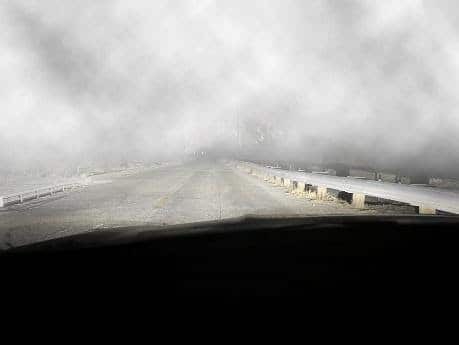
When not to Use Fog Lights
In clear weather fog lights should not be used, this is because they may cause undue glare or dazzle oncoming drivers. In California fog light laws are specifically described in the California Vehicle Code Sections 24400-24011.
Legal Aspects of Headlight Use
Correctly using high-beam and low-beam headlights is not only a safety measure but also a legal requirement in many jurisdictions. Failure to use your headlights appropriately can lead to being warned by an officer of the law, cited, and points on your license. For example, as of 2023 California Vehicle Code 24409 states that drivers that fail to dim their headlights will receive a fine of $238.00 and one point on their DMV driving record.
Embracing High-Beam Assist Technology
More and more new vehicles are now being equipped with automatic high-beam assist technology. This system addresses the underuse of the high beam lights due to the driver having to manually switch back and forth between high and low beams. Multiple studies have found that drivers find having to manually switch between low and high beams irritating and tiresome, which results in the underuse of high beams which would actually be beneficial to the driver. High beam assist systems normally utilize the windshield mounted camera on your vehicle to detect vehicles in front of your vehicle. When the system determines that leading vehicles and oncoming vehicles are far enough away the system will automatically switch your headlights from low to high, and automatically switch back to low when a vehicle is detected (IMAGE 6). This automatic process allows the headlights to be at the optimal setting for all driving conditions, providing additional illumination when appropriate and an added layer of convenience and safety for the driver.
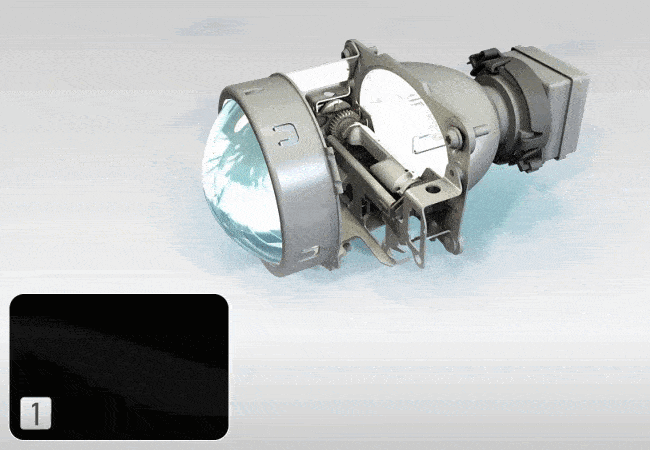
Conclusion
Correctly using your vehicle’s headlights and fog lights is a crucial aspect of safe driving. By understanding when and how to use your lights, you can enhance your visibility, reduce eye fatigue, and contribute to safer roads for everyone.
Remember, driving is not just about getting from point A to point B; it’s about ensuring you and everyone else on the road gets home to their loved ones safely.

